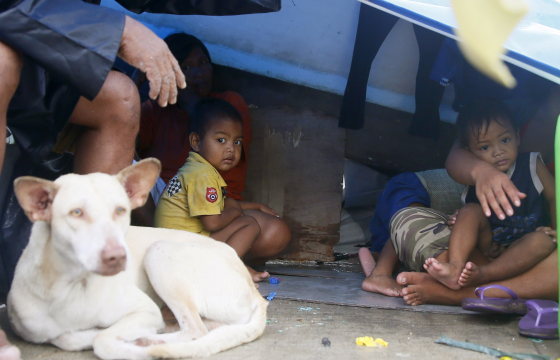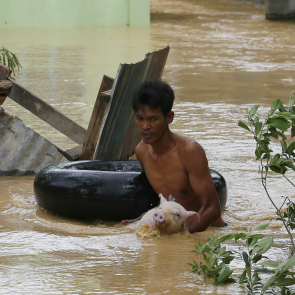Catholic relief workers in the Philippines said that their major concern was in areas where there had been no communication as the latest death toll for Typhoon Koppu reached 16 people on Monday night.
Some areas had suffered some form of destruction to 100 per cent of its infrastructure, according to weather experts monitoring the slow-moving typhoon, which has deluged some of the countries islands with up to three metres of rainfall in under 72 hours.
Catholic Relief Services country director Joe Curry said teams from his agency and Caritas Philippines were making their way to at least three provinces in central and eastern Luzon, where much of the damaging floods have been reported.
"Our biggest concern is what we're not hearing from certain areas where the storm had the biggest impact, especially in northern parts of Aurora province," Curry told Catholic News Service on Monday night. "This is where the storm sat for about four hours before it made landfall."
Typhoon Koppu is the second strongest storm to hit the disaster-plagued Southeast Asian archipelago this year and has already forced more than 60,000 people from their homes, authorities said. Although the typhoon, which made landfall on Saturday on the eastern coast of Luzon, the country's main island in the north, has seen winds reach up to 108mph, the biggest concern is the slow speed the typhoon is moving at, which is causing severe flooding.
On Saturday night, high winds toppled power lines, uprooted trees and ripped off roofs. But the pounding rains caused chest-high flooding in some areas, while swollen rivers overflowed and forced some residents to their rooftops.
The Philippines authorities said that more than 280,000 people were affected by the storm. About 70,000 were in evacuation centres.
Koppu, with cloud coverage spanning 375 miles, moved westward slowly and was expected to continue dumping more rain over much of Luzon.
Curry said aid agencies also were concerned about Nueva Ecija and Nueva Vizcaya provinces.
"Those are areas around the Pampanga River, which is now flooding, and the flooding will continue because the rain is still coming through," he said.
In mountain towns, rescue workers towing residents with rope maneuvered rolling currents of brown muddy water that had poured down the mountainsides.
Curry said his office has been in touch with dioceses in central Luzon, but it could not make contact with any churches or the diocese on the east.
In Isabela and Cagayan provinces, the International Federation of Red Cross and Red Crescent Societies said residents who vacated their homes took to the streets when evacuation centers in their towns became overcrowded. It said the Philippine Red Cross served about 4,100 meals and setting up support services for the displaced.
While Koppu moved northwest at 3 miles per hour, the head of the state weather bureau said some parts on the west could expect half a month's worth of rain in a 24-hour period.
 Aid workers are unsure how many people have been affected by Typhoon Koppu in the Philippines (PA)
Aid workers are unsure how many people have been affected by Typhoon Koppu in the Philippines (PA)
"There are so many villages on deep slopes in mountains and in valleys near rivers that are very vulnerable to landslides and flooding, so that's what we want to watch out for in the next couple of days," Curry said.
On Friday, President Benigno Aquino made a televised warning, the first time he had done so since Super Typhoon Haiyan in 2013, which killed more than 6,300 people.
The Red Cross and Red Crescent are still carrying out recovery work of infrastructure destroyed by Haiyan, the most powerful typhoon to make landfall in history.
It battered the Philippines: 1.1 million people were made homeless, while 16 million people were affected – one sixth of the country’s population. The scale of the destruction was without precedent.
As well as homes, Haiyan wiped out crop staples, fisheries, schools and health facilities. Several thousand rural health centres and schools were rendered unusable.
KEEP UP TO DATE ON TWITTER...
Follow all the latest news and events from the Catholic world via The Tablet's Twitter feed @the_tablet




 Loading ...
Loading ...